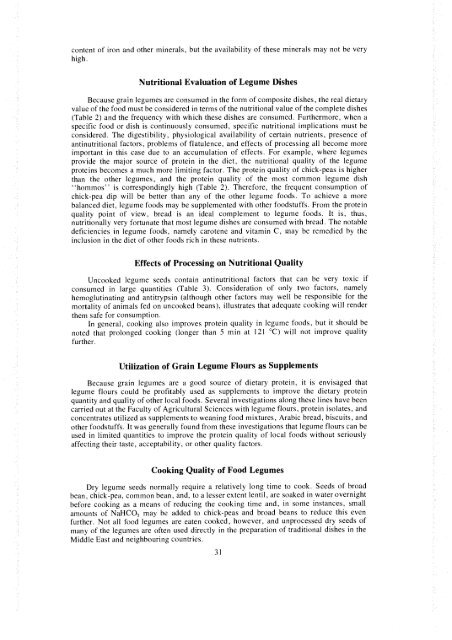I ARCHIV - International Development Research Centre
I ARCHIV - International Development Research Centre
I ARCHIV - International Development Research Centre
- No tags were found...
Create successful ePaper yourself
Turn your PDF publications into a flip-book with our unique Google optimized e-Paper software.
content of iron and other minerals, but the availability of these minerals may not be very<br />
high.<br />
Nutritional Evaluation of Legume Dishes<br />
Because grain legumes are consumed in the form of composite dishes, the real dietary<br />
value of the food must be considered in terms of the nutritional value of the complete dishes<br />
(Table 2) and the frequency with which these dishes are consumed. Furthermore, when a<br />
specific food or dish is continuously consumed, specific nutritional implications must be<br />
considered. The digestibility, physiological availability of certain nutrients, presence of<br />
antinutritional factors, problems of flatulence, and effects of processing all become more<br />
important in this case due to an accumulation of effects. For example, where legumes<br />
provide the major source of protein in the diet, the nutritional quality of the legume<br />
proteins becomes a much more limiting factor. The protein quality of chick-peas is higher<br />
than the other legumes, and the protein quality of the most common legume dish<br />
"hommos'' is correspondingly high (Table 2). Therefore, the frequent consumption of<br />
chick-pea dip will be better than any of the other legume foods. To achieve a more<br />
balanced diet, legume foods may be supplemented with other foodstuffs. From the protein<br />
quality point of view, bread is an ideal complement to legume foods. It is, thus,<br />
nutritionally very fortunate that most legume dishes are consumed with bread. The notable<br />
deficiencies in legume foods, namely carotene and vitamin C, may be remedied by the<br />
inclusion in the diet of other foods rich in these nutrients.<br />
Effects of Processing on Nutritional Quality<br />
Uncooked legume seeds contain antinutritional factors that can be very toxic if<br />
consumed in large quantities (Table 3). Consideration of only two factors, namely<br />
hemoglutinating and antitrypsin (although other factors may well be responsible for the<br />
mortality of animals fed on uncooked beans), illustrates that adequate cooking will render<br />
them safe for consumption.<br />
In general, cooking also improves protein quality in legume foods, but it should be<br />
noted that prolonged cooking (longer than 5 mm at 121 °C) will not improve quality<br />
further.<br />
Utilization of Grain Legume Flours as Supplements<br />
Because grain legumes are a good source of dietary protein, it is envisaged that<br />
legume flours could be profitably used as supplements to improve the dietary protein<br />
quantity and quality of other local foods. Several investigations along these lines have been<br />
carried out at the Faculty of Agricultural Sciences with legume flours, protein isolates, and<br />
concentrates utilized as supplements to weaning food mixtures, Arabic bread, biscuits, and<br />
other foodstuffs. It was generally found from these investigations that legume flours can be<br />
used in limited quantities to improve the protein quality of local foods without seriously<br />
affecting their taste, acceptability, or other quality factors.<br />
Cooking Quality of Food Legumes<br />
Dry legume seeds normally require a relatively long time to cook. Seeds of broad<br />
bean, chick-pea, common bean, and, to a lesser extent lentil, are soaked in water overnight<br />
before cooking as a means of reducing the cooking time and, in some instances, small<br />
amounts of NaHCO3 may be added to chick-peas and broad beans to reduce this even<br />
further. Not all food legumes are eaten cooked, however, and unprocessed dry seeds of<br />
many of the legumes are often used directly in the preparation of traditional dishes in the<br />
Middle East and neighbouring countries.<br />
31

















